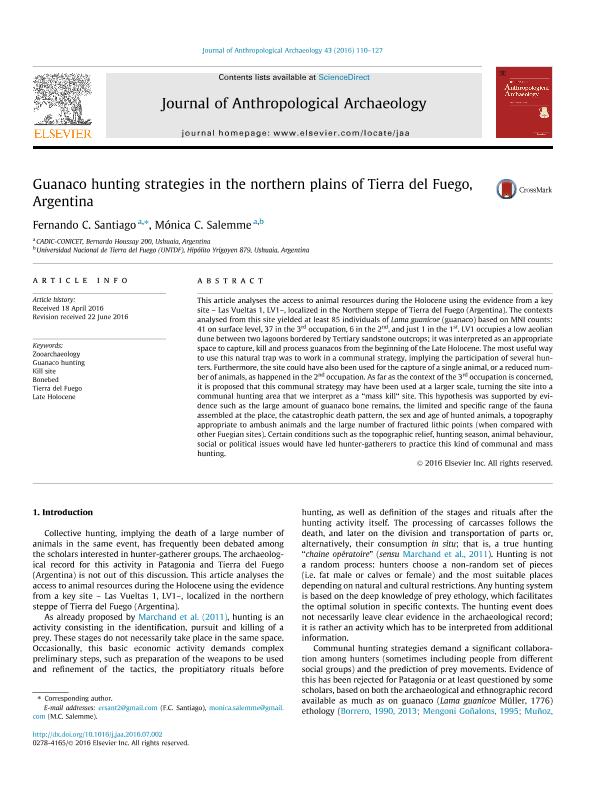Mostrar el registro sencillo del ítem
dc.contributor.author
Santiago, Fernando Carlos

dc.contributor.author
Salemme, Monica Cira

dc.date.available
2020-01-14T19:02:37Z
dc.date.issued
2016-09
dc.identifier.citation
Santiago, Fernando Carlos; Salemme, Monica Cira; Guanaco hunting strategies in the northern plains of Tierra del Fuego, Argentina; Elsevier; Journal of Anthropological Archaeology; 43; 9-2016; 110-127
dc.identifier.issn
1090-2686
dc.identifier.uri
http://hdl.handle.net/11336/94637
dc.description.abstract
This article analyses the access to animal resources during the Holocene using the evidence from a key site – Las Vueltas 1, LV1–, localized in the Northern steppe of Tierra del Fuego (Argentina). The contexts analysed from this site yielded at least 85 individuals of Lama guanicoe (guanaco) based on MNI counts: 41 on surface level, 37 in the 3rd occupation, 6 in the 2nd, and just 1 in the 1st. LV1 occupies a low aeolian dune between two lagoons bordered by Tertiary sandstone outcrops; it was interpreted as an appropriate space to capture, kill and process guanacos from the beginning of the Late Holocene. The most useful way to use this natural trap was to work in a communal strategy, implying the participation of several hunters. Furthermore, the site could have also been used for the capture of a single animal, or a reduced number of animals, as happened in the 2nd occupation. As far as the context of the 3rd occupation is concerned, it is proposed that this communal strategy may have been used at a larger scale, turning the site into a communal hunting area that we interpret as a “mass kill“ site. This hypothesis was supported by evidence such as the large amount of guanaco bone remains, the limited and specific range of the fauna assembled at the place, the catastrophic death pattern, the sex and age of hunted animals, a topography appropriate to ambush animals and the large number of fractured lithic points (when compared with other Fuegian sites). Certain conditions such as the topographic relief, hunting season, animal behaviour, social or political issues would have led hunter-gatherers to practice this kind of communal and mass hunting.
dc.format
application/pdf
dc.language.iso
eng
dc.publisher
Elsevier

dc.rights
info:eu-repo/semantics/openAccess
dc.rights.uri
https://creativecommons.org/licenses/by-nc-sa/2.5/ar/
dc.subject
BONEBED
dc.subject
GUANACO HUNTING
dc.subject
KILL SITE
dc.subject
LATE HOLOCENE
dc.subject
TIERRA DEL FUEGO
dc.subject
ZOOARCHAEOLOGY
dc.subject.classification
Arqueología

dc.subject.classification
Historia y Arqueología

dc.subject.classification
HUMANIDADES

dc.title
Guanaco hunting strategies in the northern plains of Tierra del Fuego, Argentina
dc.type
info:eu-repo/semantics/article
dc.type
info:ar-repo/semantics/artículo
dc.type
info:eu-repo/semantics/publishedVersion
dc.date.updated
2020-01-13T14:22:08Z
dc.journal.volume
43
dc.journal.pagination
110-127
dc.journal.pais
Estados Unidos

dc.description.fil
Fil: Santiago, Fernando Carlos. Consejo Nacional de Investigaciones Científicas y Técnicas. Centro Austral de Investigaciones Científicas; Argentina
dc.description.fil
Fil: Salemme, Monica Cira. Consejo Nacional de Investigaciones Científicas y Técnicas. Centro Austral de Investigaciones Científicas; Argentina. Universidad Nacional de Tierra del Fuego; Argentina
dc.journal.title
Journal of Anthropological Archaeology
dc.relation.alternativeid
info:eu-repo/semantics/altIdentifier/doi/http://dx.doi.org/10.1016/j.jaa.2016.07.002
dc.relation.alternativeid
info:eu-repo/semantics/altIdentifier/url/https://www.sciencedirect.com/science/article/pii/S0278416516300642
Archivos asociados
